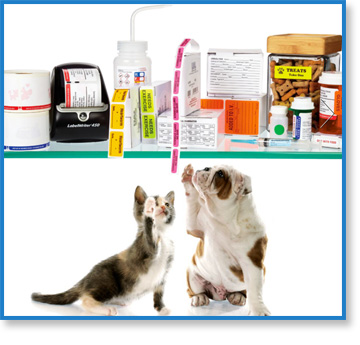
Clients
Pet owners are taking a more active role in their pet’s care than ever before. That makes effective communication essential. Consider these tips:
Clients don’t remember what they are told. In fact, one study showed that they only recalled 40% of the information they were given about their pet. And, almost half of what they thought they remembered was incorrect. But, these steps helped increase the accuracy:
-
Color (not black & white) printing is more captivating. It aids understanding and helps clients better retain information
-
When follow up is required, include specific due dates to create urgency
-
Keep it simple. Give basic information, such as symptoms, risk factors, and how to treat or prevent. Simple, brightly colored, medication communication labels help ensure appropriate dispensing
Communication labels are one way to convey this information and ensure a greater understanding.
Pets
Unfortunately, pets can’t tell you when something is wrong. Communicating care is essential to their treatment.
For surgery, treatments and other overnight stays
Communication labels enhance your care. Placed on cages and medical records, they detail each patient’s specific needs and care requirements.
Senior or geriatric pets require extra attention and communication
As pets live longer, a significant portion of a veterinary practice patients are seniors. Using instruction and communication labels help guide effective care. Cage Cards combined with brightly colored care instruction labels makes your staff acutely aware of a senior pets special needs.
Care labels serve a dual purpose
They guide your staff and are visible to pet owners making them aware of the attentive care their pets receive.
Medication Dispensing
If your client needs to dispense medication at home, medication instruction labels ensure proper treatment. Fill line labels clearly guide the proper amount of medication that should be added to a vile. Instruction labels placed on drugs will ensure medications are used for their intended purpose.
Staff
Although you communicate directly with your staff, communication labels help you provide instructions when you aren’t there.
Night Shift Challenges
Working the night shift creates numerous challenges for both the practice and the staff. Although completing procedures and writing medical records are part of the routine, detailing other instructions improve productivity and the quality of care.
Using cage cards and care instruction labels help you provide those details and keep your operation running smooth at anytime of day or night.
Compliance
Medication labeling and record keeping is critical to your practice. Written treatment records and proper prescription drug labeling are required to remain compliant. DYMO, Thermal and Laser labels help you keep track.
For more information on how United Ad Label can help improve the efficiency of your veterinary practice, browse our selection of veterinary labels or contact us at 800-423-4643 or ual-cs@rrd.com.